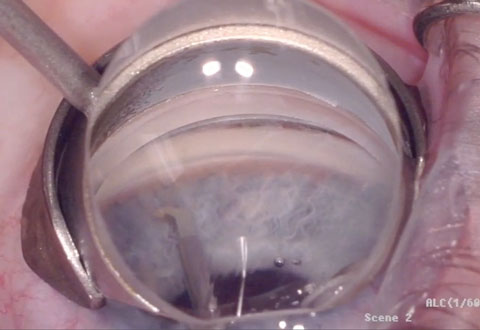  |
Minimally invasive glaucoma surgeries (MIGS) continue to provide safe and effective options for eye care providers (ECP) caring for patients with mild to moderate glaucoma. Combining MIGS with cataract surgery, or performing them as standalone procedures, potentially provides powerful IOP lowering and a greater safety profile than traditional filtration surgeries. The Kahook Dual Blade (New World Medical) is yet another device that has recently made its debut in the world of MIGS.
Kahook Dual Blade
The device is designed to facilitate the reduction of IOP by removing a section of trabecular meshwork (TM) and the inner wall of Schlemm’s canal. Using direct gonioscopy, the dual blade is inserted through a clear corneal incision and advanced to the opposite angle. The blade is designed to conform to the drainage angle anatomy of the human eye. The sharp tip of the device penetrates the TM and enters Schlemm’s canal. The ramp of the device elevates the TM toward the dual blades, where it is incised. It performs an ab interno trabeculectomy by engaging TM and cutting the target tissue while minimizing leaflets left in place and damage to adjacent tissues. The result is nearly complete excision of TM.
It can be a stand-alone procedure, which is quick, or performed in combination with cataract surgery. Some surgeons are combining the Kahook Dual Blade, which targets aqueous outflow, with endocyclophotocoagulation, which targets aqueous production.
 |
| The dual blade is designed to allow the surgeon to lift and excise the trabecular meshwork completely. |
Supporting Research
A study compared tissue samples undergoing histologic processing and comparative analyses of a dual-blade device, a microvitreoretinal (MVR) blade and Trabectome (NeoMedix Corporation).1 Researchers also performed human eye perfusion studies to evaluate IOP lowering effects of each device.1 All devices resulted in statistically significant lowering of IOP during perfusion model studies, with the dual-blade device achieving a more complete removal of TM without injury to surrounding tissues compared with the other devices.1
Advantages
Because the Kahook Dual Blade procedure is quick and painless, requiring no sutures and providing rapid postoperative visual recovery, patient satisfaction is often high. Unlike trabeculectomies, it carries no risk of bleb-related infections or bleb leaks.
Disadvantages
Visualizing the angle anatomy and TM is crucial, and using the Kahook Dual Blade without it can be challenging. Additionally, visual acuity can be reduced postoperatively secondary to mild hyphema, which is a typical finding after most forms of goniotomy. If visual acuity is reduced, patient education is imperative to explain that resolution of the hyphema and visual recovery will take about a week.
Postoperative Care
The Kahook Dual Blade, when used for a standalone procedure, is managed postoperatively with an NSAID plus a topical antibiotic for prophylaxis. If the procedure is done in conjunction with cataract surgery, ECPs can prescribe a typical regimen of topical steroid, NSAID and topical antibiotic for prophylaxis. Antibiotic-steroid injections, such as TriMoxiVanc/TriMoxi (Imprimis Pharmaceuticals), are another option. n
Dr. Schweitzer is a cornea, glaucoma, cataract and refractive surgery specialist at Vance Thompson Vision in Sioux Falls, SD.
| 1. Seibold LK, Soohoo JR, Ammar DA, Kahook MY. Preclinical investigation of ab interno trabeculectomy using a novel dual-blade device. Am J Ophthalmol. December 4, 2012. [Epub ahead of print]. |

